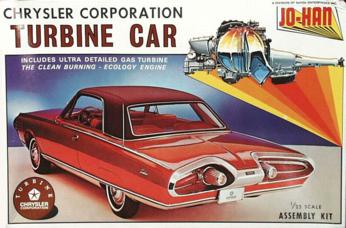|
|
|
|
|
Turbine
Car
Vibration-free power from a lightweight, simple compact engine has long been the dream of automobile designers. Today, this dream has come true through the new revolutionary Chrysler Corporation Turbine Car. Designed exclusively for its turbine engine, the four-passenger, two-door hardtop has exterior styling emphasizing the turbine theme. The power plant is similar to a pint-size aircraft jet engine. Compressed air is heated by the burning fuel in the combustion chamber where hot gasses expand to drive the turbines, delivering power to the wheels of the car. The turbine engine contains 80% fewer parts than a comparable piston engine, is smaller in size and lighter in weight. It requires no radiator or liquid cooling system. The electrical system uses a storage battery, starting generator, coil and one (1) spark plug. |
 Click image above to see a close-up 
|
|
Dave's comments: Here's a great link to this car.
Now here's
the rest of the story as relayed by top modeler Scott Doyle who
combined research and personal experience for this contribution to the
Rally:
When the three years were up 40 of the 50 cars were scrapped, under the watchful eyes of the customs people, and Chrysler paid to keep the other 10. Two were kept for further tests and the others were sent to auto museums. Harrah's in Reno had one and the most famous one went to the Museum of Science and Industry in Chicago. This one is driven occasionally at Chrysler shows and I have a color photo of it driving that you may want for your site. The cars were given to average citizens to drive. 30,000 people applied from all 50 states and 15 countries. 203 people were chosen to drive the car for three months apiece. They ranged in age from 21 to 70, 180 were men and 23 women. They lived in 133 different cities in the 48 contiguous states. The drivers were sworn to secrecy about performance and fuel consumption. The car sucked the gas, 25% of the drivers complaining about this. Chrysler wasn't concerned about this as they felt that the operators were used to driving lighter cars with less performance and that they spent a lot of time starting and stopping the car as they demonstrated it to friends or the car spent an inordinate amount of time idling as people gathered around to look at and talk about the car. Journalists were allowed to test drive the car, but none were allowed to spend any significant time with it. All journalists were accompanied by a factory rep. who put limitations on what could be done with it. The negatives were acceleration lag, no dynamic braking (no engine resistance when the gas was let up on and the car coasted) and the technology did not exist to manufacture turbine engines anywhere near the cost of a piston engine. The positives were fuel choice (anything from gas, kerosene, JP-4 jet fuel). Any flammable fuel could be used except for leaded gas since lead deposits would form on the engine components. Another advantage was that the engine had 80% fewer parts than a piston engine. The owners manual had six preventive maintenance functions: 1.
Ensure proper fuel selection. On a personnel level, my dad had the opportunity to drive a turbine car for a day. He worked for Chrysler at the time (they paid for me to come into the world), and he was able to get one. |
unbuilt |
